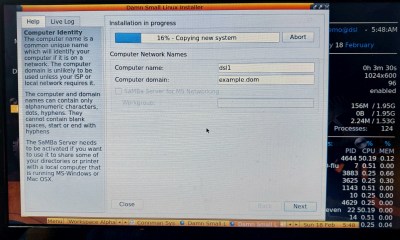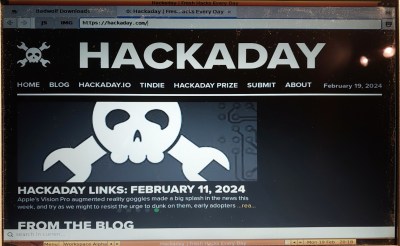There was a time when the gulf between a new computer and one a decade or more old was so large as to be insurmountable; when a Pentium was the chip to have an older computer had a 16-bit 8086 or 286. Here in the 2020s, though, that divide is less stark. While a machine from the mid-2000s may no longer be considered quick, it can still run modern and useful software.
The problem facing the owner of such older hardware though is that as operating systems advance their requirements and eclipse their machine’s capabilities. A perfectly good machine becomes less useful, not because the tasks it needs to be used for are beyond it, but because the latest OS is built with higher-spec hardware in mind. The subject of today’s test is an operating system designed to make the best of older hardware, and it’s one with a pedigree. Damn Small Linux, or DSL, first appeared in 2005 as a tiny distro for the old machines of the day, and after a long hiatus it’s back with a 2024 edition.
Old Stuff Is Pretty Fast, These Days
So much time has passed since the last DSL release, that what’s considered an old or low-spec computer has moved forward. Thus DSL is no longer the 50 megabyte mini-CD ISO of yore, and has moved to the 700 megabytes of a full-sized CD. This is still a significant constraint, but the extra space means that the new DSL 2024 can provide something much closer to the full-featured desktop OS that people expect.

It has a choice between the Fluxbox or JWM window managers, it has BadWolf as its default browser, and AbiWord and Gnumeric as its office applications. Under the hood it borrows heavily from the AntiX live Linux distro, and the version we’re testing is very much an alpha. I’ve got the perfect machine to test it on, a late-2000s HP netbook with an annoyingly slow 32-bit single-core Atom processor, so it’s time to download the ISO and give it a try.
The first experience was disappointing, because the ISO wouldn’t boot when installed on a Flash drive. Who’s got a spare blank CD-ROM hanging around in 2024? Certainly not me: while I’m certain I still own some, I think they’re packed away in storage somewhere. So it was time for a bit of fault finding, which led me to isohybrid, part of the syslinux package. This tool performs the magic to make an ISO 9660 file bootable on a Flash drive, something that I guess I should know more about than I do, given that ISOs were my entire life for a while. It did the trick though, and after a false start with corrupted video and booting into a pre-configured safe video mode, I was soon in the DSL installer.
It’s a relatively painless process as it is with so many modern Linux distributions, and after the usual questions about locale and disk allocation it was ready to reboot. Installing 700 megabytes of software doesn’t take long, and my netbook was booting into its new OS in short order. Here the folly of trying an alpha release of a new Linux distro shows itself, because naturally, the wireless network on the little HP was unrecognized. I can say that the OS felt snappy on a 32-bit Atom, but that was it for that machine in this test.
Finally, A Stripped Out OS With A Wrencher-Capable Browser!
Happily I was able to put it on a vanilla Intel Core Duo Dell laptop and continue. The network connected without issues, and it was time to get stuck in.

As always my task was to do my everyday work of editing Hackaday, and since DSL 2024 uses BadWolf as its browser it was time to fire that up and give the Wrencher a try. Since this browser uses the WebkitGTK engine I expected it to work, and it took me without problems into both the main site and the WordPress back end. This piece has mostly been written on it, just to underscore the Daily Drivers title. It was perfectly usable though understandably not fast, but it compared favourably to Firefox on Lubuntu on the same hardware.
As shipped, DSL 2024 doesn’t come with GIMP, so I couldn’t fix any Hackaday graphics. But there we come to the difference between this DSL and the original. This is a derivative of antiX, which is in turn based upon Debian, so I should be able to run apt in search of new software. And so it turned out, first I was able to run the usual software update, then install my graphics package of choice. The original DSL was a much more custom distro, so this access to the full Debian repository is certainly useful.
DSL 2024 may still be in alpha status and perhaps a few things won’t work, but it’s certainly a stripped-out minimalist 32-bit distro that runs well on the 2000s-era hardware I gave it. That it’s a Debian derivative makes it a leap away from the original DSL, but perhaps given that so much time has passed the two distros shouldn’t be seen in the same light. Certainly the ability to install extra software easily turns it from a novelty into something really useful. When a later version supports that netbook WiFi card, I think it’ll find a permanent home there, turning a barely useful machine into something I can edit Hackaday on if I need to. Definitely a win.

















DSL brings me to the time I was just an intern (2007) and was discovering Linux.
Same, but circa ’95
When I were a lad it booted from a floppy.
“When I were a lad it booted from a floppy.”
There is the Freesco Project which is a free Cisco router replacement that boots from a floppy. Freesco is showing its age these days, but it still works:
http://www.freesco.org/
It’s back! DSL used to be my debug distro since it fit on tiny flash drives. I used to have a 64MB and a 254MB. Not all old machines support USB boot though so Plop Boot Manager on a floppy helps.
I like this new direction for DSL. Optimize for CPU/memory resources rather than disk space. Disk space is hardly a constraint anymore. I see 64GB flash drives selling for $5. So I think 700MB is a nice target – that’s full size CDs, or 1GB flash drives plus headroom
I know we can all google or make an educated guess but how ’bout a link to the actual product?:
http://www.damnsmalllinux.org/
also for those wondering “what makes this different from other compact distributions designed to run on old hardware?” the site makes it even more explicit than the article:
“The new goal of DSL is to pack as much usable desktop distribution into an image small enough to fit on a single CD, or a hard limit of 700MB. This project is meant to service older computers and have them continue to be useful far into the future.”
(it also focuses specifically on 32-bit x86 hardware)
that’s… actually a surprisingly useful thing to target (and manageable goal) for the old-pc-hardware niche.
As with most HaD articles the link you’re looking for is the very first link in the article.
Thanks for the article. Fun read.
“Who’s got a spare blank CD-ROM hanging around in 2024?” Well, looking in one of my home office drawers, I have at least one spool of blank CDs. Several DVD spools, and one Blu-ray spool. All my desktops have a DVD drive in them, and I have an external Blu-ray/DVD/CD reader/burner for the occasional use. But yeah, not used hardly ever with thumb drives and portable SSD and HDDs so handy. Times are changing!
I have AntiX Linux running on an Acer Aspire One netbook from 2008 with only one GB of RAM. I’m not sure how DSL would be an improvement.
If it’s already installed then there’s little difference. DSL is now AntiX trimmed for to 700MB.
It’s back? Aw little penguin we missed you
just to be that guy
A core2 duo with 8 gigs of ram and a sata ssd can run windows 10 quite snappy and even the very first atom had a 64 bit instruction set.
It might be more interesting to see how this performs on a 1.x ghz p3 or Athlon XP
https://en.wikipedia.org/wiki/Intel_Atom
Not correct on the atom bit. First gen were 32 bit only
intel’s ark website disagrees
K, dawg.
Intel’s ark website disagrees
https://ark.intel.com/content/www/us/en/ark/products/36331/intel-atom-processor-n270-512k-cache-1-60-ghz-533-mhz-fsb.html
One of the earliest atom processors available, with a release date of approximately June 2008 – and per Intel’s own website, a 32-bit limited processor. The refreshed series of the 1st gen Atoms that came out a couple years later certainly did bring 64-bit capabilities to the Atom lineup. Op was inaccurate in their statement, anon’s response was a little ambiguous but on the money.
Y’all love to throw factoids around but e’rrybody skips on the fact checking. Kinda sad, it took me longer to type this comment up than to look up a couple details on google.
I run a very stripped down windows 7 64 bit on my little compaq netbook. It’s also a single core atom with 4 GB of RAM. I got the boot time to a useful desktop down to 30ish seconds, which I don’t think is half bad considering it’s running the original HD.
I still use the thing occasionally for MC stuff and reading OBD trouble codes. It’s kinda slow loading anything online, though.
Antix itself is happy with E8400 duocore CPU. Daily driver for the past 6-7 years.
Thanks, putting on list to try for my Toshiba Libretto 50CT https://en.wikipedia.org/wiki/Toshiba_Libretto
Let us know how that goes! I might too (but, don’t think there was even USB? Might need PCMCIA ethernet to hoover it up).
I thought I had a really clear memory of someone using DSL in a place I would only have been in 2004 and really early 2005. I wonder if that could have been a pre-1.0 version. Did they make them available?
I remember TomsRTBD fitting on 1 3.5″ 1.44mb floppy disk 💾
I thought the kernel dropped 32 bit support?
Nope. There’s still a lot of 32 bit Linux around, not just x86 but plenty of Arm too. Look here for how current it is: https://github.com/torvalds/linux/tree/master/arch/x86
“when a Pentium was the chip to have an older computer had a 16-bit 8086 or 286.”
What about the 386 and 486?
Back in those days a desktop PC was $2,000 easily. And $2,000 then was equivalent to something more than that now.
I used to pick up old machines, mostly 286s very cheap. Those were usable for the case, power supply and drives. Sure, the hard drives were small but the goal was a minimum usable machine, not something on par with the $2,000 store bought special. Also, I was getting the old machines cheap enough I could combine the hard drives of 2 or 3 to get the space I needed. Anyway, often after hacking the case a bit with a Dremel I could get a 486 motherboard in there.
Win95, Netscape + MSWord (an old version but good enough to write a school paper) and an instant messenger client (ah.. the 90s). It was enough to run those. It could even play mp3s if there was space to store them. Although… not so good with multitasking and playing an mp3. Best option was to boot do DOS for that.
Or install Linux instead. Then it could multitask well enough that Netscape and an MP3 player could just co-exist. That really showed the quality difference of Windows and Linux back in the day.
Fun times!
If you’d like to compare to something that’s stayed somewhat small, there’s also Slitaz, which has not completely gone away yet. Its rolling release livecd seems to be 43MB at the moment.
There’s also Tinycore Linux 23mb, 17mb without a desktop
I like tinycore, though it is starting to get big. The frugal install is up to like 17MB these days. I miss the old days when it was more like 11.
Tinycore is still around? I guess I won’t throw out the 256MB drive lol
https://vanilla-dpup.github.io/ DPup is Puppy Linux based on Debian 12 latest.
Debian being the mainstream OS >3000MB
DPup has compatibility at just 300MB
I’ve always been a fan of Puppy, quite a few of my drives have a version of it and it’s a lovely reminder that an OS doesn’t need gigabytes to function.
I think the concept of DSL 2024 is wrong. Another antiX (it’s cool), really?
There are also TCL, Slax, Porteus, etc., and other specialized *ELECs.
The old DSL could be given a second life by static compilation like busybox, or router software, a NON-systemd initialization system, and strict filtering of what is necessary in dependent packets with the loss of secondary functions. But not for long, as the programs are rapidly gaining fat.
As a variant of the reincarnation of OLD DSL, the transition to the TUI interface. Here you can build a really small Linux. And, as a secondary application, ARM systems have now become widespread, which still need light software. And a side effect could be independence from the GUI layer.
Dont forget Gparted and also this project: https://github.com/maaaaz/GPartedPlusPlus
If it can’t run Linux and Doom there’s no point in keeping an old machine.
Just FYI: RC1 is out with a lot more firmware included.
DSL is one of my old school favorites, haven’t used it in years, may be time to give it another whirl..
Thx
:)
I keep an old HP netbook (pink) that belonged to my daughter many years back; she’s a Mac girl now and the netbook was found under the LR couch and was headed to Goodwill. I took it back and installed
Raspberry Pi Desktop for PC (or MAC)
which runs acceptable on the Atom-based unit. Great for mucking around with the occasional RPi since the distribution is nearly identical.
I don’t think you can claim “700 megabytes” as damn small even in these bloatware days… Maybe MSl – Mid Sized Linux.